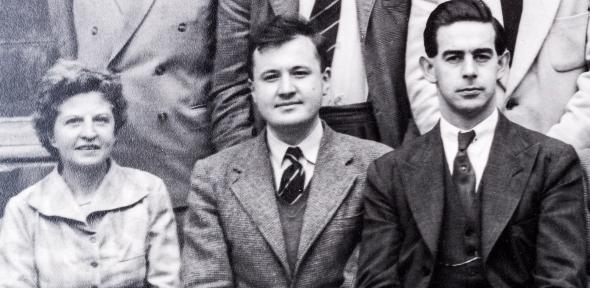
The explosive lectures that took place here in 2019 to celebrate 'The International Year of the Periodic Table' have reminded former Head of Department Professor Brian Thrush (pictured above) of the lectures he attended in the 1940s...
"Demonstration lectures that included flames and explosions took place in the Department last year to celebrate the 150th anniversary of the publication of Mendeleev’s Periodic Table. Such lectures follow in a tradition," he writes, "that I remember from the demonstrations given by Professor Ronald Norrish in his Part I lectures back in the late 1940s.
"One demonstration involved an exploding treacle tin that held its audience’s attention during its long induction time.
"This item was included in a demonstration kit that Prof Norrish sent to Mendeleev’s fellow Russian Academician, Nikolai Semenov, in Moscow. Norrish and Semenov were close contemporaries, born one year apart, and were the leaders in gas kinetics – and particularly combustion – for many years.
"I remember one demonstration, involving an exploding treacle tin, that held its audience's attention..."
Semenov received the Nobel Prize in 1956 for his work on chemical kinetics and chain reactions. Norrish had to wait longer to become a Nobel Laureate, learning on the eve of his 70th birthday in 1967 that the Prize had been awarded jointly to him and George Porter for the technique of flash photolysis. (See the article about this, 'Quick as a Flash', which appears on the right of this page.)
I began research in 1949 with Morris Sugden, measuring ionisation in luminous flames, and from 1950 I used flash photolysis to study the explosive combustion of hydrocarbons. By 1967, my research had moved to discharge flow systems, including laser magnetic resonance spectroscopy for free radical reactions. A visit to the Academy Institutes of Chemical Physics in Moscow and Yerevan for their 50th anniversaries in the 1970s showed that Semenov and his school (notably including Viktor Talrose) covered far more topics than was possible in Cambridge, but included laser magnetic resonance.
In 1976, I was delighted to be invited to the celebration of Academician Semenov’s 80th birthday at the Institute of Chemical Physics in Moscow. By then, the focus on chain reactions had moved from combustion to the depletion of stratospheric ozone by free radicals derived from halocarbons.
At the celebratory banquet – with its innumerable 'down the hatch' toasts – I was shepherded by Talrose, together with Sherry Rowland, who was to win a Nobel Prize for predicting the ozone depletion problem. As the latter was teetotal ('Sherry' having nothing to do with alcohol, but being an abbreviation of the name 'Sherwood') , I was left to withstand the full force of the Russian hospitality!"
Main image: Brian as seen in a Department photo taken in 1954. He is seated next to Delia Agar.
Image, top right: Brian photographed more recently, in 2017.

